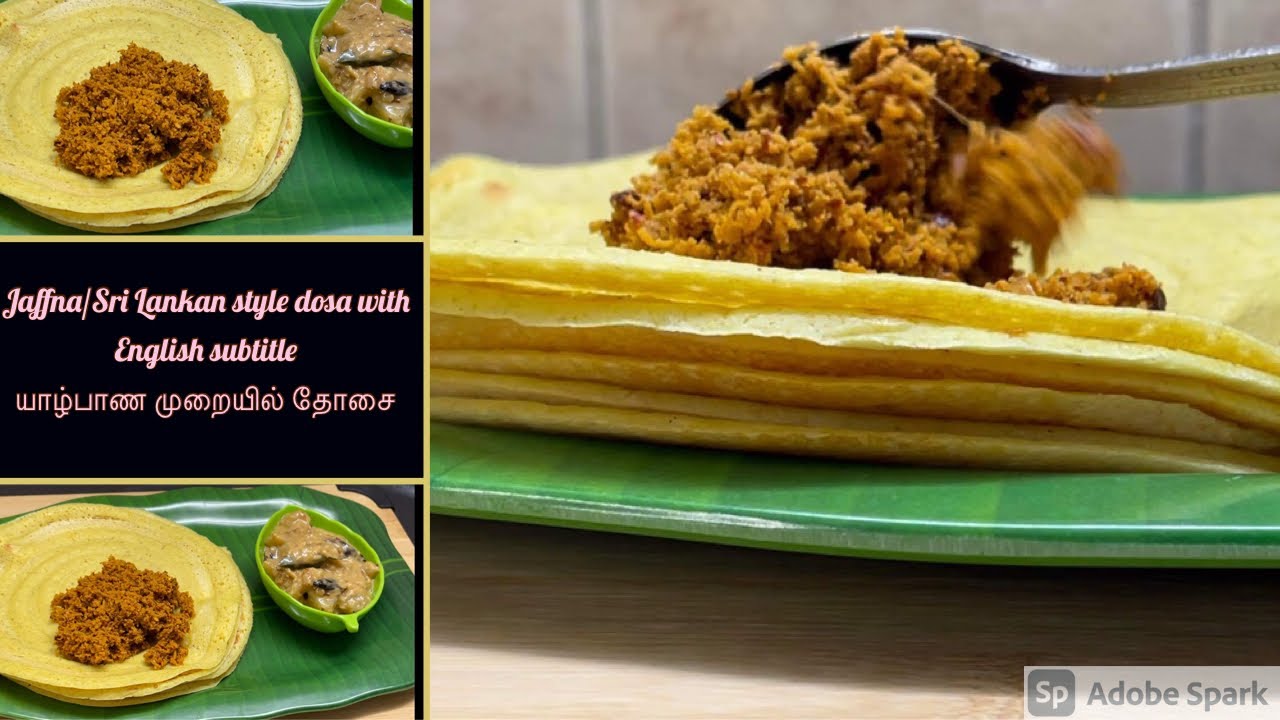Last Updated on July 27, 2023
Welcome to the world of Sri Lankan cuisine! In this article, we will explore the art of making Sri Lankan Dosa, a popular and delicious dish that is enjoyed by many. Whether you are a seasoned cook or a beginner in the kitchen, this step-by-step guide will help you create a mouthwatering dosa that is sure to impress your family and friends. From the essential ingredients to the cooking techniques, we will cover everything you need to know to achieve the perfect texture and flavor. So, let’s dive in and discover the secrets of making a delectable Sri Lankan Dosa!
Ingredients needed for Sri Lankan Dosa
When it comes to making Sri Lankan Dosa, it is important to have the right ingredients. Here are the key ingredients you will need:
- Rice: You will need both regular rice and parboiled rice. The combination of these two types of rice gives the dosa its unique texture.
- Urad dal: This lentil is an essential ingredient in dosa batter. It helps in fermenting the batter and gives the dosa a soft and fluffy texture.
- Fenugreek seeds: Adding a small amount of fenugreek seeds to the batter enhances the fermentation process and adds a subtle flavor to the dosa.
- Salt: Salt is necessary to enhance the taste of the dosa batter.
- Water: You will need water to soak the rice and dal, as well as to grind the batter to the right consistency.
By using these ingredients in the right proportions, you can create a delicious and authentic Sri Lankan Dosa.
Step-by-step instructions for making the batter
Making the batter for Sri Lankan Dosa is a crucial step in achieving the perfect texture and flavor. Here is a step-by-step guide to help you make the batter:
1. Soaking the rice and lentils: Start by soaking 2 cups of rice and 1 cup of urad dal (split black gram) in water for at least 4 hours. This will help soften the grains and make them easier to grind.
2. Grinding the batter: Drain the soaked rice and lentils and transfer them to a blender or wet grinder. Add some water and grind until you get a smooth and thick batter. The consistency should be similar to pancake batter.
3. Fermenting the batter: Transfer the batter to a large bowl and cover it with a clean cloth. Let it ferment for at least 8 hours or overnight. Fermentation is important as it helps develop the tangy flavor and airy texture of the dosa.
4. Seasoning the batter: Once the batter is fermented, add salt to taste and mix well. The batter is now ready to be used for making dosa.
By following these simple steps, you can make a delicious and authentic Sri Lankan Dosa batter at home.
Preparing the filling for the dosa
Once you have made the batter for your Sri Lankan dosa, it’s time to prepare the filling. The filling is what gives the dosa its unique flavor and adds a burst of deliciousness to every bite. There are many different fillings you can choose from, depending on your personal preferences and dietary restrictions.
One popular filling option is a spiced potato filling. To make this filling, you will need boiled potatoes, onions, green chilies, ginger, curry leaves, mustard seeds, turmeric powder, and salt. Start by heating some oil in a pan and adding the mustard seeds. Once they start to splutter, add the onions, green chilies, ginger, and curry leaves. Sauté until the onions are translucent. Then, add the boiled potatoes and mash them lightly with a fork. Finally, add the turmeric powder and salt to taste. Cook for a few more minutes until all the flavors are well combined.
If you prefer a non-vegetarian filling, you can use cooked chicken or shrimp. Simply sauté the meat with onions, garlic, and spices of your choice until it is cooked through and flavorful.
Once your filling is ready, you can start assembling your dosa. Spread a thin layer of the filling on one side of the dosa and fold it over to create a half-moon shape. Serve hot with your favorite chutney or sauce.
5. Cooking the dosa on a griddle
Once you have prepared the batter and the filling, it’s time to cook the dosa on a griddle. Follow these steps to achieve a perfectly cooked and crispy dosa:
- Heat a non-stick griddle or a dosa tawa on medium heat.
- Once the griddle is hot, pour a ladleful of the dosa batter onto the center of the griddle.
- Using the back of the ladle, spread the batter in a circular motion to form a thin and even dosa.
- Drizzle a little oil or ghee around the edges of the dosa.
- Cook the dosa on medium heat until the edges start to turn golden brown and crisp.
- Flip the dosa using a spatula and cook for another minute or until the other side is cooked and crispy.
- Remove the dosa from the griddle and place it on a serving plate.
- Repeat the process with the remaining batter, adding more oil or ghee as needed.
Remember to adjust the heat as needed to prevent the dosa from burning or sticking to the griddle. With practice, you will be able to achieve the perfect texture and flavor for your dosa.
Tips for achieving the perfect texture and flavor
When making Sri Lankan Dosa, there are a few tips and tricks that can help you achieve the perfect texture and flavor. Here are some suggestions:
- Use a combination of rice and lentils: To get the right texture, it is important to use a combination of rice and lentils in the batter. This will give the dosa a crispy exterior and a soft interior.
- Soak the ingredients properly: Soaking the rice and lentils for at least 4-6 hours, or overnight, will ensure that they blend well and result in a smooth batter.
- Add fenugreek seeds: Adding a small amount of fenugreek seeds to the batter will enhance the flavor and aroma of the dosa.
- Ferment the batter: Allowing the batter to ferment for at least 8-10 hours will give the dosa a tangy flavor and make it easier to digest.
- Spread the batter evenly: When cooking the dosa on a griddle, make sure to spread the batter evenly in a circular motion. This will ensure that the dosa cooks evenly and has a uniform thickness.
- Flip the dosa carefully: When flipping the dosa, use a flat spatula and be gentle to avoid breaking it. Cook the dosa on both sides until it turns golden brown.
By following these tips, you can make delicious and authentic Sri Lankan Dosa that will impress your family and friends.
Serving suggestions and accompaniments
Once you have prepared and cooked your Sri Lankan Dosa, it’s time to think about how to serve and enjoy this delicious dish. Sri Lankan Dosa is typically served hot and crispy, accompanied by a variety of flavorful chutneys and sauces.
Coconut chutney is a popular choice to serve with dosa. Made with fresh coconut, green chilies, ginger, and tempered with mustard seeds and curry leaves, this chutney adds a refreshing and tangy flavor to the dosa.
Sambar is another classic accompaniment for dosa. This lentil-based vegetable stew is flavored with tamarind, spices, and a variety of vegetables. It adds a rich and savory element to the dosa.
If you prefer a spicier option, you can serve dosa with gunpowder chutney. This fiery chutney is made with roasted lentils, dried red chilies, and spices. It adds a kick of heat and a burst of flavor to the dosa.
Other popular accompaniments for Sri Lankan Dosa include tomato chutney, mint chutney, and onion chutney. These chutneys can be made ahead of time and stored in the refrigerator for convenience.
Experiment with different chutneys and accompaniments to find your favorite combination and enhance the flavors of your Sri Lankan Dosa. Enjoy this versatile and delicious dish with your family and friends!
Variations and Regional Adaptations of Sri Lankan Dosa
Sri Lankan dosa, also known as “hopper,” is a versatile dish that has evolved over time to include various regional adaptations and variations. While the traditional dosa recipe remains the same, different regions in Sri Lanka have put their own spin on this popular dish.
1. Egg Hopper
One popular variation is the egg hopper, where a whole egg is cracked into the center of the dosa while it is cooking. The egg adds a rich and creamy texture to the dosa, making it a favorite breakfast option.
2. String Hopper
Another variation is the string hopper, where the dosa batter is pressed through a special utensil to create thin, noodle-like strands. These strands are then steamed and served with a variety of curries and sambols.
3. Milk Hopper
In some regions, milk is added to the dosa batter, resulting in a softer and sweeter version of the dosa. This variation is often enjoyed as a dessert or a snack.
These are just a few examples of the many variations and regional adaptations of Sri Lankan dosa. Each variation adds its own unique flavor and texture to the dish, making it a truly diverse and delicious culinary experience.
Health benefits of Sri Lankan Dosa
Sri Lankan Dosa not only satisfies your taste buds but also offers several health benefits. This traditional dish is made from fermented rice and lentil batter, which makes it a good source of carbohydrates and proteins. The fermentation process increases the bioavailability of nutrients, making it easier for your body to absorb them.
One of the key health benefits of Sri Lankan Dosa is its probiotic properties. The fermentation process promotes the growth of beneficial bacteria in your gut, which can improve digestion and boost your immune system. These probiotics also help in maintaining a healthy gut flora, which is essential for overall well-being.
Additionally, Sri Lankan Dosa is low in fat and cholesterol, making it a heart-healthy choice. It is also gluten-free, making it suitable for individuals with gluten intolerance or celiac disease. The dosa is rich in vitamins and minerals, including B vitamins, iron, and calcium.
By incorporating Sri Lankan Dosa into your diet, you can enjoy a delicious and nutritious meal that provides you with energy, supports digestion, and contributes to your overall health and well-being.
Experience the Delight of Sri Lankan Dosa
After following the step-by-step instructions and learning about the variations and regional adaptations of Sri Lankan Dosa, it is time to conclude this culinary journey. The delicious and nutritious Sri Lankan Dosa is a dish that is not only easy to make but also offers a burst of flavors and textures that will leave you craving for more.
By using the right ingredients and following the tips provided, you can achieve the perfect texture and flavor that will make your dosa stand out. Whether you prefer a traditional filling or want to experiment with different accompaniments, Sri Lankan Dosa offers endless possibilities to satisfy your taste buds.
So, gather your ingredients, heat up your griddle, and embark on a culinary adventure with Sri Lankan Dosa. Whether you are a seasoned cook or a beginner in the kitchen, this dish is sure to impress your family and friends. Enjoy the delightful experience of Sri Lankan Dosa and savor every bite!
Learn how to make Sri Lankan Dosa with this easy step-by-step guide. Enjoy a delicious and nutritious meal at home!
About The Author

Alison Sowle is the typical tv guru. With a social media evangelist background, she knows how to get her message out there. However, she's also an introvert at heart and loves nothing more than writing for hours on end. She's a passionate creator who takes great joy in learning about new cultures - especially when it comes to beer!

